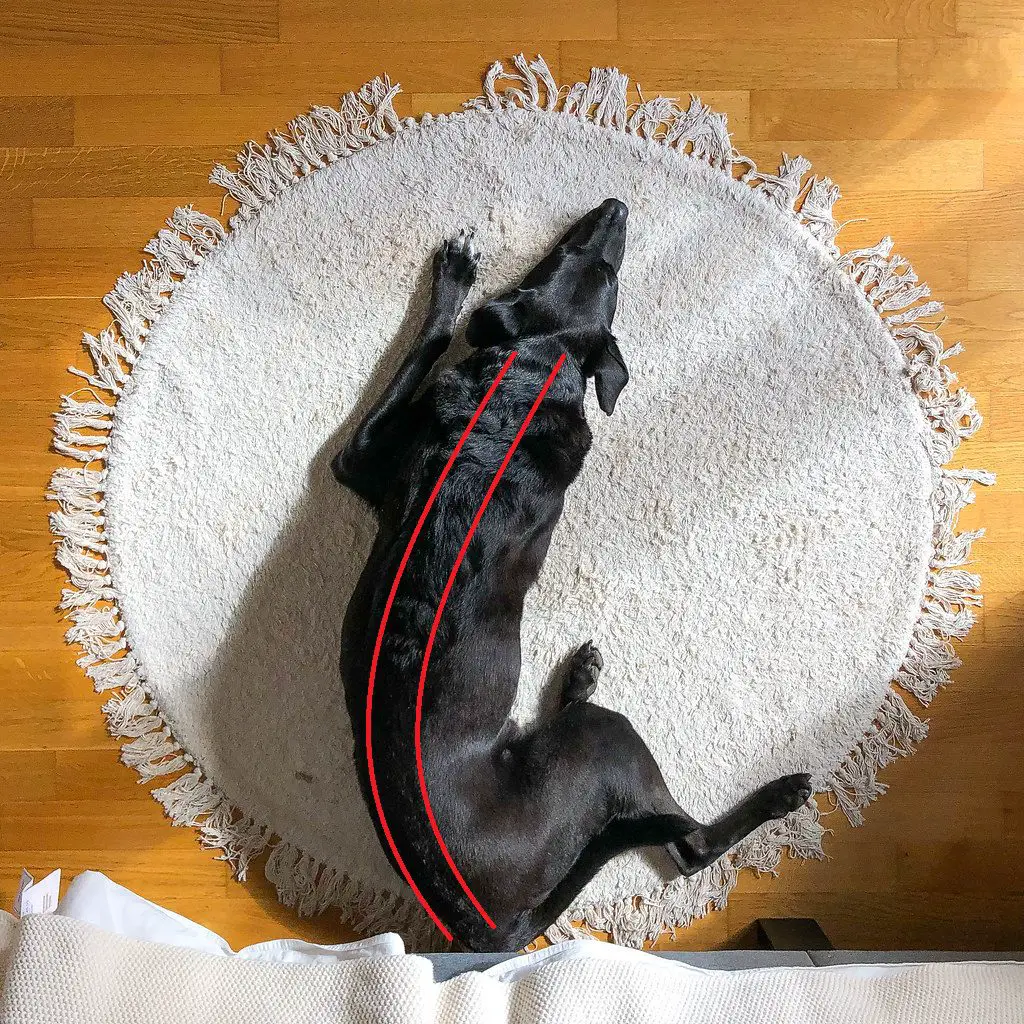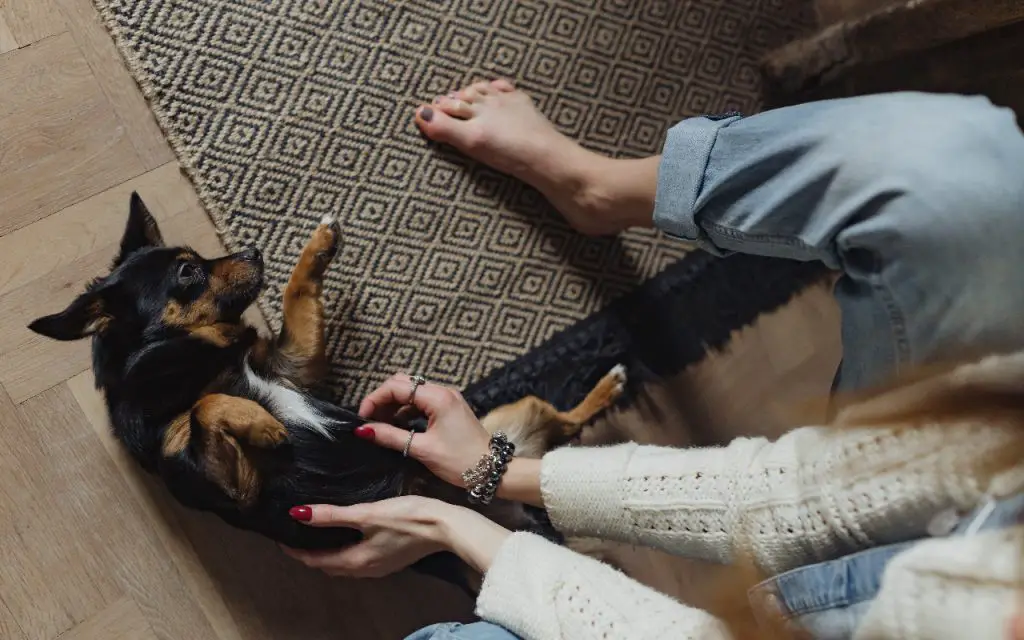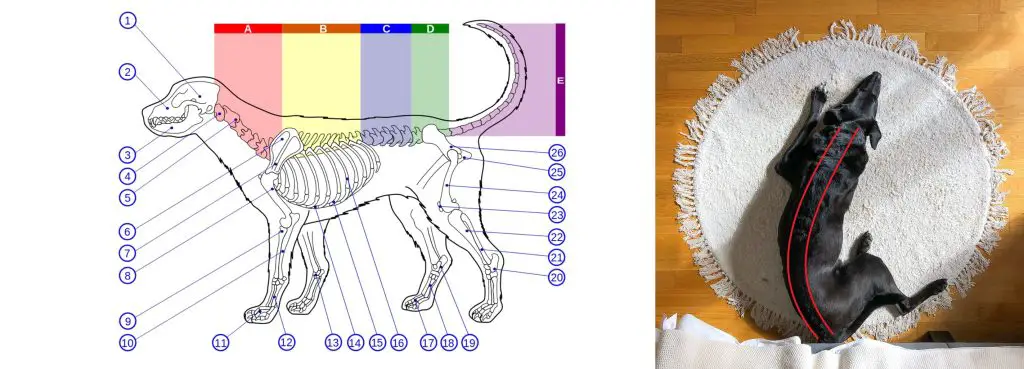Dogs with spondylosis need a regular massage to help keep their muscles loose and relieve pain. This can be a difficult task, but with the proper technique, it can be easy and beneficial for both you and your dog.
In this guide, I will teach you how to massage your dog with spondylosis using simple techniques that will help improve their quality of life.
Key Takeaway
- Canine spondylosis is a degenerative condition in dogs where bony spurs, also known as osteophytes, develop along the edges of the vertebrae in the spine, causing stiffness and potential discomfort.
- To massage a dog with spondylosis, start with short one to two-minute massages along the spine using gentle pressure, gradually increasing the duration, which can help manage pain and stimulate natural healing.
What Is Canine Spondylosis
Canine Spondylosis is a degenerative disease of the spine that is common in older dogs. It occurs when the vertebrae and discs in the spine start to break down and deteriorate. This can cause pain and stiffness in the back and neck and may make it difficult for your dog to move around.
The good news is that spondylosis is not usually a life-threatening condition, and there are ways to help your dog manage the pain and keep them comfortable. If you think your dog may be showing signs of spondylosis, talk to your veterinarian about treatment options. With proper care, your dog can still enjoy a good quality of life despite this condition.
There are several different treatment options available for canine spondylosis. Your veterinarian will be able to discuss the best option for your dog, depending on the severity of their condition. Treatment options include:
- Massage: There are many benefits to massage therapy, and canine spondylosis is no exception. Massage can help increase blood circulation, improve range of motion, and reduce inflammation. It can also help to release endorphins, which can help your dog feel better both physically and mentally.
- Weight management: Keeping your dog at a healthy weight can help reduce the amount of stress on their spine and joints.
- Exercise: Gentle exercise can help keep your dog’s muscles and joints strong and flexible.
- Pain medication: There are several different types of pain medication that can be used to relieve pain associated with spondylosis.
- Surgery: In some cases, surgery may be necessary to correct deformities or remove damaged disks in the spine. This is usually only done as a last resort when other treatments don’t work.
How To Massage a Dog With Spondylosis

Although spondylosis is a degenerative disease, there are treatments available to help your dog feel better. One of these treatments is massage. Massage can help increase circulation, relieve pain, and improve range of motion.
Massaging a dog with spondylosis can be really beneficial as it can relieve the pain and stiffness in the spine. Dogs with spondylosis are constantly in pain. So, giving your dog a massage will help it feel better, at least for a short period of time. Here is how to massage a dog with spondylosis:
1. Make your dog feel comfortable

Massaging a dog with spondylosis might not be easy at the beginning. Your dog might be in so much pain that it won’t let you massage it. So, it is important that you make your pup as comfortable as possible.
One way to help your dog feel more comfortable during a massage is to ensure that they are calm before starting. You can do this by spending some time petting them and letting them get used to your touch. Once they seem relaxed, you can begin the massage.
If at any point during the massage, your dog becomes agitated, take a break and try again later. With patience and practice, you and your dog will be enjoying massages in no time!
2. Locate your dog’s spine

To find your dog’s spine, start by feeling along the top of its back. You should be able to feel a row of bumps running down the center of their back. These bumps are called vertebrae, and they make up your dog’s spine.
Once you’ve found the vertebrae, you can locate your dog’s spine by following it down to its tail. The spinal cord runs through the center of the vertebrae, so if you trace it all the way down, you’ll find your dog’s spine.
The dog’s spine does not continue into the tail. The tail is actually made up of a series of bones called vertebrae that are connected to the dog’s spine. However, there is a small piece of cartilage at the end of the dog’s spine that gives the tail its flexibility.
3. Press-pull-release technique

The press-pull release is probably one of the best techniques to use when massaging a dog with spondylosis. This basic technique is used to release the tight tissue that is compressing a joint.
Most of the joint problems in dogs are the shortening and tightening of tissue around a joint that compresses the joint and causes pain.
Using one hand, you will be pressing, then pulling, and then releasing spots on your dog’s spine. As you massage, pay attention to any areas that seem particularly tight or sore – these areas will likely benefit from extra attention.
4. Start from the head
Once you get your dog in a comfortable state, it is time to start the massage. Warm up your hands by rubbing them together for a few seconds. Once your hands are warm, begin massaging your dog’s spine using the press-pull-release technique.
If you have an X-ray of your dog and you know the exact location of the degenerative discs on the back, it can help a lot. Knowing where to give that extra attention is great. However, make sure that you also do the whole spine, from the head to the tail.
As you are massaging different areas of the spine, you will feel a difference. Healthy tissue is supple, whereas unhealthy tissue is a little more ropey. But, don’t worry. As you do this massage every day, you will feel that those areas are becoming more flexible as you press pull and release.
5. Massage your dog every day
Massaging your dog every day is very important. However, in the beginning, do not despair if your dog doesn’t enjoy the massage. Start with one to two-minute massages and then slowly increase the duration of the massage.
Your dog will quickly learn that after the massage, there is no more pain in the spine than what was a one-minute massage can easily turn into a thirty-minute session.
Symptoms of Spondylosis In Dogs
The symptoms of spondylosis in dogs can vary but typically include stiffness in the back, lameness, changes in gait, and pain, although many dogs with this condition may show no apparent symptoms.
Stiffness in the Back
One of the most common symptoms of spondylosis in dogs is stiffness in the back. This stiffness is due to the formation of bony spurs along the edges of the vertebrae in the spine, which can limit the dog’s flexibility and movement.
Lameness
Lameness, or difficulty moving, is another potential symptom of spondylosis in dogs. The extent of the lameness can vary depending on the severity of the condition and the location of the bony spurs.
Changes in Gait
Spondylosis can also lead to noticeable changes in a dog’s gait or the way they walk. These changes can include limping, reluctance to move, or an unusual walking pattern.
Pain
While many dogs with spondylosis show no apparent symptoms, some can experience pain. This pain can range from mild discomfort to severe pain, depending on the extent of the spinal degeneration.
Lack of Apparent Symptoms
Interestingly, many dogs with spondylosis do not show any obvious symptoms. This is particularly true in cases where the condition is at a lower grade of ankylosis, or fusion of the vertebrae.
As the dog grows older and develops more osteophytes that weld together, symptoms may become more noticeable.
Severe Cases
In severe cases of spondylosis, the pressure put on the spinal cord due to the swelling of the vertebrae and discs can cause a variety of symptoms, including weakness, loss of coordination, and even paralysis.
Though rare, some severe cases may require surgical intervention to relieve the pressure on the spinal cord caused by the bone spurs.
The Benefits of Massage For a Dog With Spondylosis
Massaging a dog with spondylosis can help increase blood circulation, stimulate the release of endorphins for pain alleviation, improve mobility and flexibility, and reduce stress and anxiety.
Improved Blood Circulation
Massage therapy can help increase blood circulation in dogs, which is particularly beneficial for those suffering from spondylosis. Improved blood flow can help in delivering necessary nutrients to the affected areas and accelerate the healing process.
Endorphin Release for Pain Alleviation
Massaging muscles stimulates the release of endorphins, which are natural pain relievers. This helps in managing the pain associated with spondylosis, thereby improving the quality of life for your canine companion.
Enhanced Mobility and Flexibility
Spondylosis can lead to stiffness and reduced range of motion in dogs. Regular massages can help relieve this stiffness and improve both mobility and flexibility, allowing your dog to move more freely and comfortably.
Reduction of Stress and Anxiety
Just like in humans, massage therapy can have a calming effect on dogs too. It helps reduce stress and anxiety levels, which can be particularly beneficial for dogs dealing with the discomfort and changes brought about by spondylosis.
Pain Management and Control
Massage can also help control referred pain due to nerve irritation and ease surrounding tissues. This contributes to overall better pain management, providing relief to your pet from the constant discomfort caused by spondylosis.
Additional Support for Dogs with Spondylosis
Additional support for dogs with spondylosis can include a combination of physical therapy, dietary changes, pain management, and lifestyle modifications to help manage the condition and improve the dog’s quality of life.
Physical Therapy
Physical therapy can play a significant role in supporting dogs with spondylosis. Regular exercises designed to strengthen the muscles surrounding the spine can help support the affected areas, reduce pain, and improve mobility.
Dietary Changes
Dietary changes can also provide additional support. Foods rich in omega-3 fatty acids, such as fish oil, can help reduce inflammation. Additionally, maintaining a healthy weight is crucial to avoid putting extra pressure on the spine.
Pain Management
Pain management is a critical aspect of supporting dogs with spondylosis. This can involve medication prescribed by your vet, as well as natural remedies like massage, to help alleviate discomfort and improve the dog’s overall well-being.
Lifestyle Modifications
Lifestyle modifications can also help manage spondylosis in dogs. These can include providing a comfortable and supportive bed, using ramps instead of stairs, and avoiding activities that put extra stress on the spine, such as jumping or running.
Regular Vet Check-ups
Regular vet check-ups are essential to monitor the progression of the disease and adjust treatment plans as necessary. This allows for early detection of any potential complications and enables proactive management of the condition says VCAHospitals.
FAQs
Q: How is spondylosis diagnosed?
A: Spondylosis can be diagnosed through physical examination and imaging techniques such as x-rays. X-rays can show the presence of bone spurs and the extent of the condition.
Q: What are the treatment options for spondylosis in dogs?
A: Treatment options for spondylosis in dogs include pain management, physical therapy, laser therapy, massage therapy, and in severe cases, surgical intervention.
Q: Can massage therapy help with spondylosis in dogs?
A: Yes, massage therapy can help reduce pain and inflammation associated with spondylosis. It can improve blood circulation, promote relaxation, and increase range of motion in affected dogs. It is important to consult a professional canine massage therapist to ensure the technique is appropriate for your dog’s condition.
Q: How does massage therapy help a dog with spondylosis?
A: Massage therapy helps a dog with spondylosis by reducing muscle tension, improving flexibility, and increasing the production of endorphins, which are natural pain-relieving chemicals in the body. It can also help reduce the formation of scar tissue and promote healing.
Q: Can massage therapy be used as the sole treatment for spondylosis in dogs?
A: Massage therapy can complement other treatment modalities for spondylosis in dogs, but it is not typically used as the sole treatment. It is important to consult with a veterinarian to develop a comprehensive treatment plan that addresses the specific needs of your dog.
Q: Is massage therapy safe for dogs with spondylosis?
A: Massage therapy is generally safe for dogs with spondylosis, but it is essential to work with a trained and experienced canine massage therapist who can tailor the massage techniques to your dog’s specific condition. It is important to avoid applying excessive pressure or manipulating the affected areas aggressively.
Q: Where can I find a qualified canine massage therapist?
A: You can find qualified canine massage therapists through professional organizations such as the Canine Massage Guild or by asking for recommendations from your veterinarian or other dog owners who have used massage therapy for their dogs.
Q: Can massage therapy cure spondylosis in dogs?
A: Massage therapy cannot cure spondylosis, as it is a degenerative condition. However, it can help manage the symptoms, reduce pain and inflammation, improve quality of life, and slow down the progression of the disease.
Conclusion and final thoughts
In conclusion, massaging a dog with spondylosis can greatly benefit their overall well-being and ease the discomfort caused by this condition.
It is important to consult with a veterinarian before starting any massage therapy on your dog. Remember to be gentle and use slow, controlled movements while massaging your dog.
Always pay attention to their body language and adjust accordingly.




